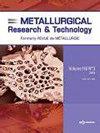氧枪倾角对电弧炉钢液脱碳动力学影响的CFD研究
IF 0.9
4区 材料科学
Q3 METALLURGY & METALLURGICAL ENGINEERING
引用次数: 1
摘要
在电弧炉炼钢中,主要的化学反应是脱碳反应。用超音速或相干射流注入氧气,并在高温下与钢液中的溶解碳进一步发生化学反应,从而促进该反应。建立了在无顶渣层情况下,喷注角度、氧气流量和喷枪数量对钢水脱碳动力学影响的三维数学模型。该模型已使用文献中报道的实验数据进行了验证。模型表明,从水平方向减小注入角度有利于脱碳动力学,从而改善了熔池运动和反应动力学。研究结果表明,减小工业电弧炉的电流注入角可以提高脱碳率。其主要机理是气体射流对液体运动的影响。考虑到从水平方向减小喷射角度会促进飞溅,采用数值模型预测提出了可替代的解决方案,以达到高脱碳率。本文章由计算机程序翻译,如有差异,请以英文原文为准。
CFD study on the effect of the oxygen lance inclination angle on the decarburization kinetics of liquid steel in the EAF
In Electric Arc Furnace (EAF) steelmaking the main chemical reaction is the decarburization reaction. This reaction is promoted by the injection of oxygen using supersonic or coherent jets and further chemical reaction with dissolved carbon in liquid steel at high temperatures. A 3D mathematical model to describe the effect of the injection angle, oxygen gas flow rate and number of lances on the decarburization kinetics of molten steel, in the absence of the top slag layer has been developed. The model has been validated using experimental data reported in the literature. The model shows that the decarburization kinetics is promoted by decreasing the injection angle from the horizontal, condition that improves both bath movement and reaction kinetics. These findings suggest that current injection angles in industrial EAF’s can be decreased in order to improve the decarburization rate. The main mechanism is the effect of the gas jet on the motion of the liquid. Taking into consideration that decreasing the injection angle from the horizontal promotes splashing, the numerical model predictions are employed to suggest alternative solutions in order to reach high decarburization rates.
求助全文
通过发布文献求助,成功后即可免费获取论文全文。
去求助
来源期刊

Metallurgical Research & Technology
METALLURGY & METALLURGICAL ENGINEERING-
CiteScore
1.70
自引率
9.10%
发文量
65
审稿时长
4.4 months
期刊介绍:
Metallurgical Research and Technology (MRT) is a peer-reviewed bi-monthly journal publishing original high-quality research papers in areas ranging from process metallurgy to metal product properties and applications of ferrous and non-ferrous metals and alloys, including light-metals. It covers also the materials involved in the metal processing as ores, refractories and slags.
The journal is listed in the citation index Web of Science and has an Impact Factor.
It is highly concerned by the technological innovation as a support of the metallurgical industry at a time when it has to tackle severe challenges like energy, raw materials, sustainability, environment... Strengthening and enhancing the dialogue between science and industry is at the heart of the scope of MRT. This is why it welcomes manuscripts focusing on industrial practice, as well as basic metallurgical knowledge or review articles.
 求助内容:
求助内容: 应助结果提醒方式:
应助结果提醒方式:


